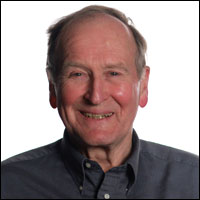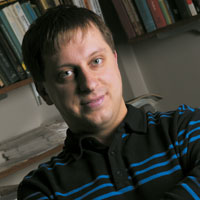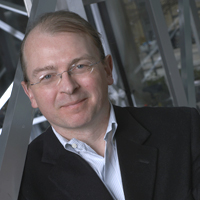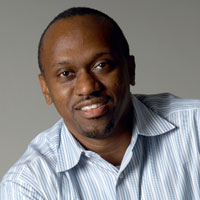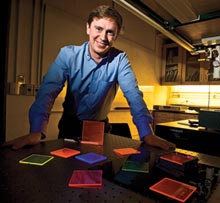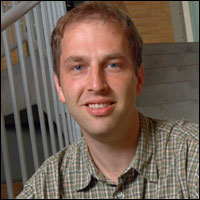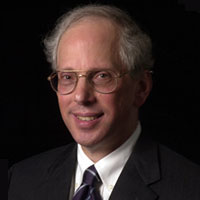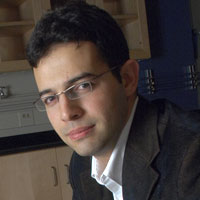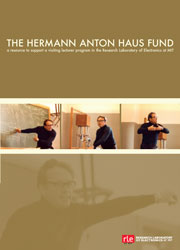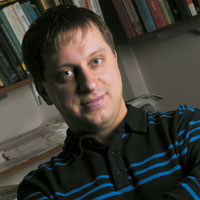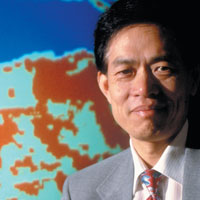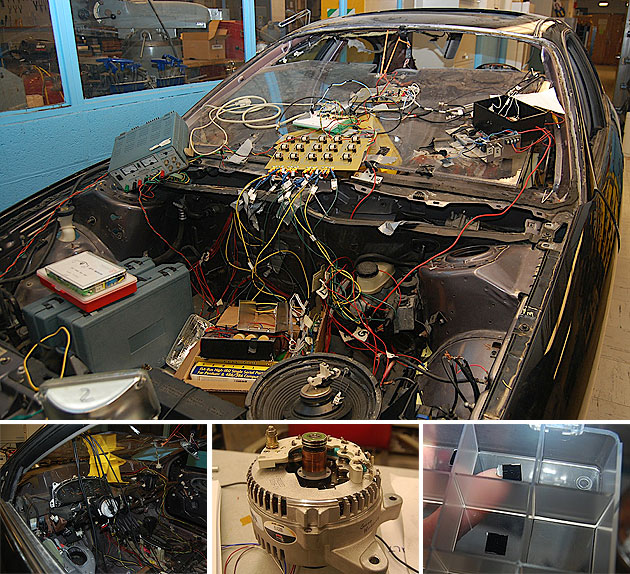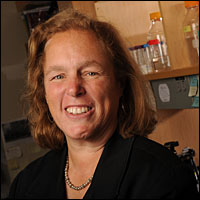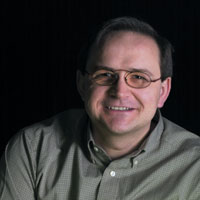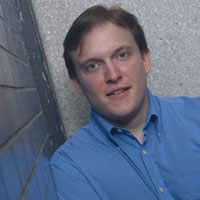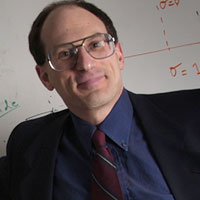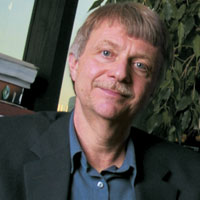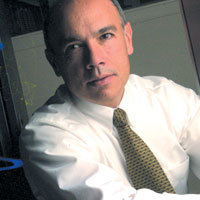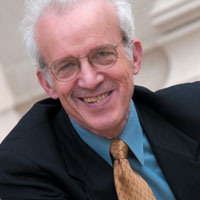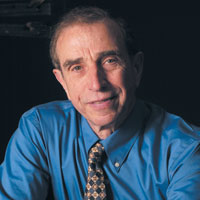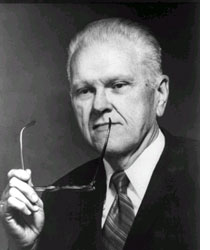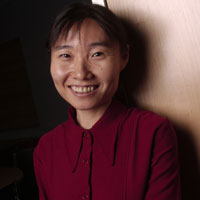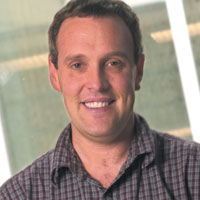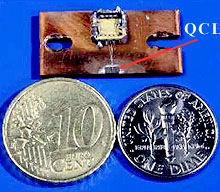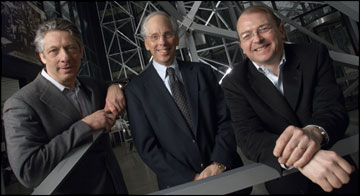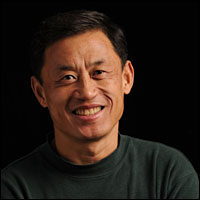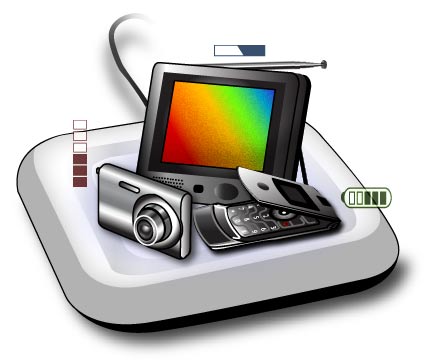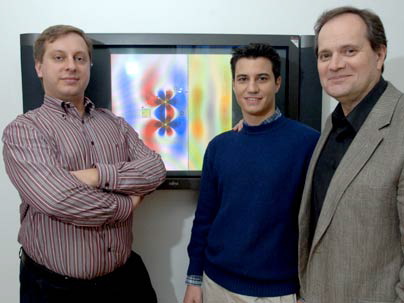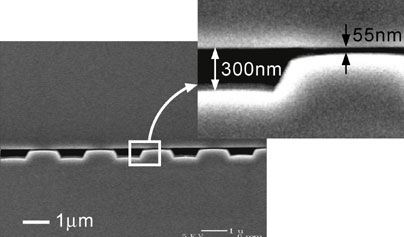RLE News
Professors Luca Daniel and Jing Kong named 2008 recipients of the Jonathan Allen Junior Faculty Award
The Research Laboratory of Electronics (RLE) at the Massachusetts Institute of Technology (MIT) has named Luca Daniel, Associate Professor of Electrical Engineering, and Jing Kong, Assistant Professor of Electrical Engineering, to receive 2008 Jonathan Allen Junior…
Eight MIT faculty named to the AAAS
Eight MIT faculty members will be inducted into the American Academy of Arts and Sciences (AAAS) as part of its new class of 190 fellows and 22 foreign honorary members, including Professor Henry I. Smith. «more» Related Links: Eight MIT faculty named to…
Marin Soljacic named 2008 MacArthur Fellow RLE physicist wins “genius” grant
Marin Soljacic is a young theoretical physicist whose work on several aspects of electromagnetic waves holds important implications for understanding fundamental principles of optical physics and for development of devices such as switches for optical computers and…
Two MIT faculty win MacArthur ‘genius’ grants Winners each get $500,000 in unrestricted funds
Two MIT faculty members—a physicist and a structural engineer who studies architectural history—have won 2008 MacArthur Fellowships, commonly known as “genius” grants. Marin Soljacic ’96, assistant professor of physics, and John Ochsendorf, associate professor of…
MIT quantum insights could lead to better detectors: Improved efficiency could enable research, military and medical uses
A bizarre but well-established aspect of quantum physics could open up a new era of electronic detectors and imaging systems that would be far more efficient than any now in existence, according to new insights by an MIT leader in the field. «more»…
MIT probe could aid quantum computing: Spectroscopy, with amplitude
MIT researchers may have found a way to overcome a key barrier to the advent of super-fast quantum computers, which could be powerful tools for applications such as code breaking. Ever since Nobel Prize-winning physicist Richard Feynman first proposed the theory of…
MIT zeroes in on Alzheimer’s structures: Work could lead to new drugs for the common disease
MIT engineers report a new approach to identifying protein structures key to Alzheimer’s disease, an important step toward the development of new drugs that could prevent such structures from forming. «more» Related Links: MIT zeroes in on Alzheimer’s…
Intensifying the Sun: A new way to concentrate sunlight could make solar power competitive with fossil fuels
In his darkened lab at MIT, Marc Baldo shines an ultraviolet lamp on a 10-*centimeter square of glass. He has coated the surfaces of the glass with dyes that glow faintly orange under the light. Yet the uncoated edges of the glass are shining more brightly–four neat,…
Building microchips from the bottom up: MIT develops novel self-assembly method that could break size barrier
Using a novel system based on molecules that can assemble themselves into precise patterns, MIT researchers have come up with a way of beating size limitations that would otherwise crimp improvements in data-storage media and electronic microchips.…
MIT awarded $3M for training program in quantum information science
MIT has been awarded a $3 million grant from the National Science Foundation to establish a pioneering doctoral-study program in the growing field of quantum information science (QIS), which has evolved rapidly recently with a new influx of ideas from quantum physics…
NSF awards $3M to MIT for a pioneering graduate training program in quantum information science
Major new grant to unify MIT’s strengths into an interdisciplinary doctoral study program spanning science and engineering The National Science Foundation (NSF), through its Integrative Graduate Education and Research Traineeship (IGERT) program, has awarded a $3M…
New windows double as solar panels
A new type of solar panel that allows light to pass through it like a pane of glass has been invented by scientists who said that it is 10 times more powerful than conventional methods of producing energy from sunlight. «more» Related Links: New windows…
Solar Panels to Dye For: Scientists show that cheap chemical dyes may lead to efficient conversion of the sun’s energy
If you think solar is still too expensive, here’s how to get more bang for your solar-cell buck. Take a small solar cell, and slice it into thin slivers. Wrap the slivers around the edges of a slab of glass. Paint the glass with a high-tech, but cheap, dye, which you…
Solar dyes give a guiding light
A new way of capturing the energy from the Sun could increase the power generated by solar panels tenfold, a team of American scientists has shown. The new technique involves coating glass with a specific mixture of transparent dyes which redirect light to…
A Better Solar Collector: A more efficient way to concentrate sunlight could reduce the cost of producing solar power
Looking to make solar panels cheaper, MIT researchers have created sheets of glass coated with advanced organic dyes that more efficiently concentrate sunlight. The researchers, whose results appear in this week’s issue of Science, say that the coated glass sheets…
MIT opens new ‘window’ on solar energy: Cost effective devices expected on market soon
Imagine windows that not only provide a clear view and illuminate rooms, but also use sunlight to efficiently help power the building they are part of. MIT engineers report a new approach to harnessing the sun’s energy that could allow just that. «more»…
Jeffrey H. Shapiro to be a recipient of the 2008 International Quantum Communication Award
Professor Jeffrey H. Shapiro will be one of three recipients of the 2008 Quantum Communication Award, given to recognize, “…outstanding achievements in quantum communication research.” «more» Related Links: Jeffrey H. Shapiro to be a recipient of the…
MIT develops a ‘paper towel’ for oil spills: Nanowire mesh can absorb up to 20 times its weight in oil
A mat of nanowires with the touch and feel of paper could be an important new tool in the cleanup of oil and other organic pollutants, MIT researchers and colleagues report in the May 30 online issue of Nature Nanotechnology. «more» Related Links: MIT…
Hope on the horizon: Life Extension
Significant extension of the human lifespan by disease-preventive and tissue-regenerative technologies within the next one to two decades will dramatically impact the world economy «more» Related Links: Hope on the horizon: Life Extension Professor…
Roozbeh Ghaffari and teammates named winners of the 2008 MIT 100K Entrepreneurship Competition
Diagnostics for All, a nonprofit company that has developed a unique process for making simple medical test kits out of paper, was the top winner of MIT’s 100K Entrepreneurship Competition. The company’s inexpensive tests require only a single drop of blood to provide…
Four Faculty in RLE to be Promoted
Medard, Adalsteinsson, Goyal and Stultz to be Promoted in July 2008 The Research Laboratory of Electronics (RLE) at the Massachusetts Institute of Technology (MIT) announces that two Department of Electrical Engineering and Computer Science (EECS) faculty and two…
Roozbeh Ghaffari and Michael Vahey Named Recipients of 2008 Peake Research Prizes
The Research Laboratory of Electronics (RLE) at the Massachusetts Institute of Technology (MIT) announces that Dr. Roozbeh Ghaffari and Mr. Michael Vahey have won Helen Carr Peake Research Prizes for 2008. Dr. Ghaffari is a February 2008 graduate of the Speech and…
Stephen E. Harris to deliver the 2008 Hermann Anton Haus Lecture
Lecture series honoring Haus brings eminent visitors to MIT The Research Laboratory of Electronics (RLE) at the Massachusetts Institute of Technology (MIT) announces that Dr. Stephen E. Harris, the Kenneth and Barbara Oshman Professor of Electrical Engineering, and…
Henry I. Smith named Fellow of the American Academy of Arts and Sciences (AAAS)
The American Academy of Arts and Sciences, one of the nation’s oldest and most prestigious honorary societies and independent policy research centers, today announced the election of a new class of members. Drawn from the sciences, the arts and humanities, business,…
Live-animal nerve regeneration study gets a boost: MIT team refines optical ‘lab on a chip’
An MIT team has improved upon its landmark technology reported last year in which the researchers used a fingernail-sized lab on a chip to image, perform surgery on and sort tiny worms to study nerve regeneration. «more» Related Links: Live-animal nerve…
Jeffrey H. Shapiro named recipient of the 2008 IEEE LEOS Quantum Electronics Award
Professors Jeffrey H. Shapiro of MIT and Horace P. Yuen of Northwestern University were named recipients of the 2008 IEEE Lasers and Electro-Optics Society (LEOS) Quantum Electronics Award for “pioneering and seminal contributions to the theory of the generation,…
Technology Review 10 Emerging Technologies 2008: Wireless Power
Physicist Marin Soljacic is working toward a world of wireless electricity. In the late 19th century, the realization that electricity could be coaxed to light up a bulb prompted a mad dash to determine the best way to distribute it. At the head of the pack was…
Jin Au Kong, long-serving EECS and RLE professor, dies at age 65
Professor Jin Au Kong, an internationally renowned expert on electromagnetic waves who served on the faculty of the Department of Electrical Engineering and Computer Science for nearly 40 years, died unexpectedly this week of complications from pneumonia. He was 65.…
Eyes on prize: Visionary device gives hope
A bionic device the size of a pencil eraser — the labor of 20 years for a group of visionary Hub doctors and scientists — is offering hope that some forms of blindness could be alleviated within a few years. «more» Related Links: Eyes on prize: Visionary…
Wieman: To lecture is human, to engage divine
As a young professor, RLE alumnus Carl E. Wieman SB ’73 figured it would be easy to get his students as excited about physics as he was. He would simply explain the subject, and students would see it with the same sterling clarity he did. «more» Related…
Remembering J. Francis Reintjes, 1912–2008
MIT Professor Emeritus J. Francis Reintjes celebrated for his keen wit and unassuming but steadfast leadership in electrical engineering and computer science, passed away February 21, 2008 after a brief illness. «more» Related Links: Remembering J.…
MIT Builds Efficient Nanowire Storage to Replace Car Batteries
Could the ultracapacitor replace lithium ion in hybrids and plug-in vehicles? Our senior automotive editor already thinks the science adds up, but it’s in a tiny box at a messy lab that the future of automotive efficiency is taking a surprising turn toward extending…
Yanik and Zwierlein Named 2008 Alfred P. Sloan Foundation Research Fellows
Professors Mehmet Fatih Yanik and Martin W. Zwierlein of RLE have been awarded 2008 Alfred P. Sloan Foundation Research Fellowships which are intended to enhance the careers of the very best young faculty members in specified fields of science. «more»…
Turning ‘funky’ quantum mysteries into computing reality
The strange world of quantum mechanics can provide a way to surpass limits in speed, efficiency and accuracy of computing, communications and measurement, according to research by MIT scientist Seth Lloyd. «more» Related Links: Turning ‘funky’ quantum…
Inclusiveness, optimism among strengths of HST’s Gray
Last winter, Harvard-MIT Health Sciences and Technology Director Martha Gray invited friends to join her for a Billy Collins poetry dinner. The evening would be styled after the famed haggis- and scotch-infused Robert Burns parties, she wrote in her invitation, only,…
James M. Daley named recipient of 2008 MIT Excellence Award
James M. Daley, Project Technician in the RLE NanStructures Laboratory (NSL), has been named one of nineteen 2008 recipients of the MIT Excellence Award, the Institute’s highest honor for staff, in the category of “Unsung Hero.” «more» Related Links:…
Franz X. Kaertner named a 2008 Optical Society of America Fellow
Professor Franz X. Kaertner was named a 2008 Optical Society of America (OSA) Fellow, “…for pioneering contributions to femtosecond pulse generation and ultrafast nonlinear optics.” «more» Related Links: Franz X. Kaertner named a 2008 Optical Society…
Zwierlein wins physics award for discovery in superfluidity
Martin Zwierlein, assistant professor of physics, was recently awarded one of Germany’s premier awards for young scientists. The 100,000 euro Klung-Wilhelmy-Weberbank Prize for physics was presented to Zwierlein at a ceremony on Nov. 16 at the Free University of…
MIT and India to create health science and technology institute
MIT and the government of India’s Department of Biotechnology today launched a partnership that will result in the creation of a new Translational Health Science and Technology Institute (THSTI) in India.«more» Related Links: MIT and India to create…
Prof. Jacob K. White named 2008 IEEE Fellow
Professor Jacob K. White, Cecil H. Green Professor of Electrical Engineering and Computer Science, was named a 2008 IEEE Fellow. Professor White was cited for his contributions to pioneering simulation tools for RF circuits, electrical interconnects, and micro…
J. Nicholas Laneman honored by President George W. Bush
RLE alumnus, J. Nicholas Laneman, Assistant Professor of Electrical Engineering at the University of Notre Dame, was named a recipient of a Presidential Early Career Award (PECASE). The PECASE is the highest honor bestowed by the U.S. government on scientists and…
MIT works toward ‘smart’ optical microchips
A new theory developed at MIT could lead to “smart” optical microchips that adapt to different wavelengths of light, potentially advancing telecommunications, spectroscopy and remote sensing. «more» Related Links: MIT works toward ‘smart’ optical…
MIT’s Deshpande Center announces fall 2007 research grants
The Deshpande Center for Technological Innovation at MIT today announced it is awarding $1,030,000 in grants to ten MIT research teams currently working on emerging technologies, including a new RLE program on throughput nanoscale imaging. «more» Related…
Yanik wins Packard fellowship for neural microchip work
Mehmet Fatih Yanik has stopped light in its tracks and created a self-contained biological laboratory, complete with large numbers of living test subjects, on the surface of a microchip. Now he is focusing on learning how to keep nerve cells from degenerating and…
MIT finds new hearing mechanism
MIT researchers have discovered a hearing mechanism that fundamentally changes the current understanding of inner ear function. This new mechanism could help explain the ear’s remarkable ability to sense and discriminate sounds. Its discovery could eventually lead to…
Professor Mehmet Fatih Yanik wins prestigious 2007 Packard Foundation Fellowship
The David and Lucile Packard Foundation has named 20 new promising scientific researchers as the 2007 recipients of Packard Fellowships for Science and Engineering. Each Fellow will receive an unrestricted research grant of $625,000 over five years.…
Four MIT faculty win NIH awards
Professors Ed Boyden, Alan Jasanoff, and Mehmet Fatih Yanik will each receive $1.5 million over five years for winning New Innovator Awards. Yanik, assistant professor in the Department of Electrical Engineering and Computer Science, will “develop microchip…
David W. Foss named 2007 recipient of the Steven Wade Neiterman Award
The Steven Wade Neiterman Award is given to individuals engaged in information technology work in any department at MIT. The award is given to individuals who share the qualities that Steve exhibited: his abilities in collaborative problem solving, in coaching…
MIT invents ‘lab on a chip’ to automate whole-animal genetic and drug screens
Genetic studies on whole animals can now be done dramatically faster using a new microchip developed by engineers at MIT. «more» Related Links: MIT invents ‘lab on a chip’ to automate whole-animal genetic and drug screens Professor Mehmet Fatih Yanik…
MIT faculty, alumni among Technology Review’s top young innovators
Several MIT faculty and alumni have been named to the TR35, Technology Review Magazine’s annual compilation of the 35 top innovators worldwide under the age of 35. «more» Related Links: MIT faculty, alumni among Technology Review’s top young innovators…
Stopping light on microchips
Mehmet Yanik, an assistant professor of electrical engineering and computer science, has invented a way to stop light pulses on a chip and release them at will. The technology could allow engineers to route and store optical data in telecommunications networks and on…
MIT trio to receive top U.S. science, technology honors
President George W. Bush presented the nation’s highest science and technology honors Friday to MIT President Emeritus Charles M. Vest, pioneering biomedical engineer Robert S. Langer and groundbreaking atomic physicist Daniel Kleppner. «more» Related…
MIT trio wins nation’s top honors for science, technology
Kleppner received the medal for pioneering studies of the interaction between atoms and light, and for “lucid explanations of physics to non-specialists.” «more» Related Links: MIT trio wins nation’s top honors for science, technology Prof. Daniel…
Three from MIT win top U.S. science, technology honors
Three distinguished members of the MIT community — President Emeritus Charles M. Vest, pioneering biomedical engineer Robert S. Langer and groundbreaking atomic physicist Daniel Kleppner — have been awarded the nation’s highest technology and science honors.…
EECS names Berggren, Goyal and Stultz to Career Development Professorships
The Department of Electrical Engineering and Computer Science (EECS) at the Massachusetts Institute of Technology (MIT) has named three Research Laboratory of Electronics (RLE) faculty to career development professorships. Karl K. Berggren was named Emanuel E.…
MIT biology, physics and nuclear science professors honored
Daniel Kleppner, the Lester Wolfe Professor Emeritus of Physics, has been chosen as the the Frederic Ives Medal/Jarus W. Quinn Endowment winner by the Optical Society of America. «more» Related Links: MIT biology, physics and nuclear science professors…
Slow light: Dynamic photon storage
Light has been the workhorse of modern telecommunications since the invention of fibre optics. The ever-increasing demand to be able to transmit information not only over the large distances between continents but increasingly over the much smaller distances such as…
WiTricity could get cords from under foot
Unless it’s your smoke alarm saving your life, mysterious electronic beeping in the middle of the night is highly annoying. It certainly annoyed Marin Soljacic a few years ago when he found himself standing in his kitchen in his pajamas in the middle of the night for…
Digital Signal Processing Pioneer To Receive IEEE Jack S. Kilby Medal
The IEEE has named Alan V. Oppenheim as the recipient of its 2007 Jack S. Kilby Signal Processing Medal, recognizing his contributions in the field of digital signal processing (DSP) which have impacted a variety of scientific disciplines including speech coding and…
MIT unveils wireless-power device
A team from the Massachusetts Institute of Technology (MIT) lit a 60-watt light bulb from a power source two metres away and with no physical connections between the source and the appliance. «more» Related Links: MIT unveils wireless-power device Prof.…
Wireless breakthrough delivers electrical energy without power cord
In a perfect world, there’d be no wires. They clutter the view, get tangled behind desks and limit how far networks can reach. «more» Related Links: Wireless breakthrough delivers electrical energy without power cord Prof. Marin Soljacic RLE ab initio…
Goodbye wires…
MIT team experimentally demonstrates wireless power transfer, potentially useful for powering laptops, and cell phones without cords. «more» Related Links: Goodbye wires… Prof. Marin Soljacic Prof. John D. Joannopoulos RLE ab initio Physics Group MIT…
Wireless Energy Lights Bulb from Seven Feet Away
If you thought wireless Internet made life convenient, try wrapping your mind around wireless power. «more» Related Links: Wireless Energy Lights Bulb from Seven Feet Away Prof. Marin Soljacic RLE ab initio Physics Group
Wireless power a reality
The mess of electrical cables that recharge our laptops, mobile phones and PDAs could soon disappear altogether—at least according to a team of US physicists, who have shown how power can be transmitted without wires using special “resonant” antennas.…
Lorraine J. Simmons named recipient of 2007 Infinite Mile Award
Lorraine is among the best of the unsung heroes of administration at MIT. She is responsible for many behind-the-scene tasks that are essential to fulfill requirements. «more» Related Links: Lorraine J. Simmons named recipient of 2007 Infinite Mile…
Optical Society of America confers Frederic Ives Medal/Jarus W. Quinn Endowment Award to Professor Daniel Kleppner
The highest award conferred by the Society for overall distinction in optics, this award is presented to Daniel Kleppner for sustained innovation, discovery and leadership in the interaction of radiation with atoms and for his service and general educational…
NMR advance relies on microscopic detector: technology could vastly improve diagnostics
Detecting the molecular structure of a tiny protein using nuclear magnetic resonance (NMR) currently requires two things: a million-dollar machine the size of a massive SUV, and a large sample of the protein under study. «more» Related Links: NMR advance…
Cheryl Charles named recipient of 2007 Infinite Mile Award
Cheryl Charles was awarded the MIT School of Engineering’s 2007 Infinite Mile Award for Diversity and Community. «more» Related Links: Cheryl Charles named recipient of 2007 Infinite Mile Award Cheryl Charles Department of Electrical Engineering and…
Laser Device Can Generate 3D Models of Human Eyes
A new way to use lasers to snap highly detailed 3‑D pictures of the eye could help improve diagnoses of many ocular diseases, engineers say. «more» Related Links: Laser Device Can Generate 3D Models of Human Eyes Prof. James G. Fujimoto RLE Laser…
10x Faster Eye Scanner Could Help Prevent Blindness
A new way to use lasers to snap highly detailed 3‑D pictures of the eye could help improve diagnoses of many ocular diseases, engineers say. «more» Related Links: 10x Faster Eye Scanner Could Help Prevent Blindness Professor James G. Fujimoto RLE Laser…
MIT team takes high-res, 3‑D images of eye
In work that could improve diagnoses of many eye diseases, MIT researchers have developed a new type of laser for taking high-resolution, 3‑D images of the retina, the part of the eye that converts light to electrical signals that travel to the brain.…
Quantum cryptography is hacked: Simulation proves it’s possible to eavesdrop on super-secure encrypted messages
A team of researchers has, for the first time, hacked into a network protected by quantum encryption. «more» Related Links: Quantum cryptography is hacked: Simulation proves it’s possible to eavesdrop on super-secure encrypted messages Prof. Jeffrey H.…
Sasha Devore, Jianping Fu, and Darren White Named Recipients of 2007 Peake Awards
The Research Laboratory of Electronics (RLE) at the Massachusetts Institute of Technology (MIT) announces that Ms. Sasha Devore has been awarded the first Helen Carr Peake Research Assistantship, while Mr. Jianping Fu and Dr. Darren Whiten have won Helen Carr Peake…
In Memorium: Professor Henry J. Zimmermann, 1916–2007
Dear Friends, It is with great sadness that I report the death of Henry J. Zimmermann, Professor Emeritus of Electrical Engineering and fourth Director of the Research Laboratory of Electronics. Professor Zimmermann died Sunday, 18 March 2007, at Meadows on Edgewood…
Seven research teams win Deshpande grants
Jing Kong will be working with colleague Francesco Stellaci to study superhydrophobic nanomaterials, a simple and rapid nanomaterial approach to controlling surface wetting that could impact how environmentally hazardous materials are cleaned. «more»…
New center to explore quantum information theory
What are the ultimate powers of quantum computers, quantum communications and quantum precision measurement systems? «more» Related Links: New center to explore quantum information theory Center for Extreme Quantum Information Theory (xQIT) Prof. Seth…
MacVicar Day celebrates diversity in learning, teaching strategies
Some people learn better when they are being graded; some do worse. Some like to go over classroom material by saying it out loud to themselves; some like to teach it to others. Some said they learn best when they look, some when they listen and some when they draw…
Rajeev J. Ram, Karl K. Berggren and Luca Daniel to be promoted in July 2007
The Executive Committee of the MIT Corporation accepted President Susan Hockfield’s recommendations for the promotion of three RLE faculty: Rajeev J. Ram from associate professor to full professor, and Karl K. Berggren and Luca Daniel from assistant professors to…
Yoel Fink named a 2007 Margaret MacVicar Faculty Fellow
Each year, members of the faculty who are outstanding teachers of undergraduate students are selected as Margaret MacVicar Faculty Fellows for a ten-year period. The Fellows form a small academy of MIT scholars committed to fine teaching and innovation in education.…
T‑Rays Advance Toward Airport Screening
Researchers around the world are trying to tap a barely used portion of the electromagnetic spectrum–terahertz radiation–to scan airline passengers for explosives and illegal drugs. «more» Related Links: T‑Rays Advance Toward Airport Screening Prof.…
High-tech fido could save lives in Iraq
When he led a U.S. Army bomb squad in Baghdad in 2003, Staff Sgt. Luke Stalcup carried electronic devices to track bombs on roads, in trash cans or in cars. But these man-made imitations of a dogÕs nose often proved disappointing. «more» Related Links:…
Eli Yablonovitch to deliver the 2007 Hermann Anton Haus Lecture: Lecture series honoring Haus brings eminent visitors to MIT
The Research Laboratory of Electronics (RLE) at the Massachusetts Institute of Technology (MIT) announces that Dr. Eli Yablonovitch, Northrop Grumman Opto-Electronics Professor of Electrical Engineering at the University of California, Los Angeles (UCLA), will deliver…
MIT team details optics-on-a-chip device
Fiber-optic networks transmit massive amounts of information quickly, but the signals weaken as the data-carrying light travels long distances. Now, researchers at the Massachusetts Institute of Technology said they’ve overcome a major obstacle in harnessing the full…
‘Microsieve’ sorts biomarkers faster
Scientists have developed a microchip system that can sieve through biomolecules, such as proteins, in search of the tell-tale signs of disease. «more» Related Links: ‘Microsieve’ sorts biomarkers faster Professor Jongyoon Han RLE Micro / Nanofluidic…
MIT Says Optical Chips Coming in 5 Years
It’s a problem chip manufacturers have known about for some time: As electronic components continue to grow more and more diminutive in size, the metal interconnects between them will soon cease to meet the needed performance criteria that devices demand. This is…
RLE ‘optics on a chip’ may revolutionize telecommunications and computing
In work that could lead to completely new devices, systems and applications in computing and telecommunications, MIT researchers are bringing the long-sought goal of “optics on a chip” one step closer to market. «more» Related Links: MIT ‘optics on a…
Professor Collin M. Stultz named 2007 recipient of the Jonathan Allen Junior Faculty Award
The Research Laboratory of Electronics (RLE) at the Massachusetts Institute of Technology (MIT) has named Collin M. Stultz, Assistant Professor of Electrical Engineering and Assistant Professor of Health Sciences and Technology, to receive the 2007 Jonathan Allen…
W. M. Keck Foundation funds major new MIT program in quantum information theory
New center seeks to revolutionize our understanding of information processing at the extreme limits posed by the laws of physics What are the ultimate powers of quantum computers, quantum communications, and quantum precision measurement systems? The new $3.5M W. M.…
MIT improves protein sorting with a new microchip
A new MIT microchip system developed in RLE promises to speed up the separation and sorting of biomolecules such as proteins. The work is important because it could help scientists better detect certain molecules, or biomarkers, associated with diseases, potentially…
Professor Qing Hu named a Fellow of the American Physical Society (APS)
Professor Qing Hu has been named a Fellow of the American Physical Society (APS). Professor Hu is cited for his, “contributions to the development of long-wavelength terahertz quantum-cascade lasers and real-time terahertz imaging.” «more» Related Links:…
A Nano Solution to Increasing Bandwidth
A nano solution to increasing bandwidth: MIT researchers develop microphotonic devices for communications, clearing the way for higher-performance optical networks. «more» Related Links: A Nano Solution to Increasing Bandwidth Professor Erich P. Ippen…
Professor Alan V. Oppenheim named the 2007 recipient of the Institute of Electrical and Electronics Engineers (IEEE) Jack S. Kilby Signal Processing Medal
Professor Alan V. Oppenheim has been named the 2007 recipient of the Institute of Electrical and Electronics Engineers (IEEE) Jack S. Kilby Signal Processing Medal. The Medal, which is sponsored by Texas Instruments, Inc., recognizes Professor Oppenheim, “For…
In the future, will our TVs be wireless?
Wouldn’t a wireless world be a wonderful thing? The light seems to be shining at the end of the tunnel. We’ve already got cord-free with our phones, remote controls, video game controls and numerous other devices. « more » Related Links: In the future,…
The vision of an MIT physicist: Getting rid of pesky rechargers
The age of convenient portable electronics is also the age of annoying rechargers. Every iPod, cellphone, and digital camera needs to be plugged in regularly or the battery dies and is useless. « more » Related Links: The vision of an MIT physicist:…
Charging Batteries without Wires
New MIT research reveals a way to send wireless energy to mobile phones and laptops. « more » Related Links: Charging Batteries without Wires Prof. John Joannopoulos Prof. Marin Soljacic RLE ab initio Physics Group
Wireless energy could power consumer, industrial electronics
Dead cell phone inspired researcher’s innovation « more » Related Links: Wireless energy could power consumer, industrial electronics Prof. John Joannopoulos Prof. Marin Soljacic RLE ab initio Physics Group
23 faculty members awarded tenure
Rahul Sarpeshkar and Yoel Fink among the 23 awarded. « more » Related Links: 23 faculty members awarded tenure Rahul Sarpeshkar Yoel Fink
Jin-Au Kong to be awarded the Docteur Honoris Causa by the University of Nantes
The Research Laboratory of Electronics (RLE) at the Massachusetts Institute of Technology (MIT) announces that Jin-Au Kong, Professor of Electrical Engineering and leader of RLE’s Center for Electromagnetic Theory and Applications (CETA), will be awarded the Docteur…
New MIT Faculty Join RLE: Collin M. Stultz and Mehmet Fatih Yanik become members of RLE
The Research Laboratory of Electronics (RLE) at the Massachusetts Institute of Technology (MIT) announces that two MIT faculty have joined the Laboratory. Professor Collin M. Stultz is Assistant Professor of Health Sciences and Technology and Assistant Professor of…
MIT’s molecular sieve advances protein research
New MIT technology promises to speed up the accurate sorting of proteins, work that may ultimately aid in the detection and treatment of disease. « more » Related Links: MIT’s molecular sieve advances protein research Jongyoon Han Micro/Nanofluidic…


